In this Issue:
- Apple, Pear: codling moth dates available; fire blight warnings
- Peach/Nectarine, Apricot, Plum: peach powdery mildew and coryneum blight fungicide at shuck split stage; peach twig borer spray dates for southern Utah
APPLE, PEAR
Codling Moth
Egg hatch prediction dates provided
View a pdf of the spray timing table. Be sure to read the instructions at the top of the pdf, for how to read the table.
Codling moth treatment timing is coming up in late-May for many areas of Utah. Some of the colder locations of the state still do not have dates.
Be prepared, because this is a pest that you need to prevent all season long for clean fruit. Whether you are growing organic or conventional, the only non-spray option for clean fruit is to bag them (click here for more info on bagging fruit.)

Treatment
Options for commercial growers.
Options for residential growers shown in the table below. Please note that this is not all-inclusive nor an endorsement of these products.
| Product Name | Efficacy | Residual Length (days) | Comments |
|---|---|---|---|
| CONVENTIONAL | |||
| Spectracide Triazicide (gamma-cyhalothrin) | Good to Excellent | 14-17 | wait 21 days to harvest |
| Monterey Bug Buster 11 (esfenvalerate) | Good to Excellent | 14-17 | wait 21 days to harvest |
| Bonide Fruit Tree & Plant Guard (lambda-cyhalothrin) | Good to Excellent | 14-17 | wait 21 days to harvest |
| Bonide Malathion; Hi Yield Malathion | Good | 5-7 | max 2 applications; some products are pears only |
| GardenTech Sevin (zeta-cypermethrin) | Good to Excellent | 14-17 | wait 14 days to harvest |
| ORGANIC | |||
| AzaSol, EcoGarden (azadirachtin) | Good | 7-10 | purchase online |
| Cyd-X (codling moth virus) | Good (if populations are low) | 7 | works best when used at beginning of generation; expensive and purchase online |
| oil such as All Seasons Oil, EcoSmart, Neem oil | Good on eggs only | 3 | recommended for first application of the generation only |
| Ortho Fruit Spray; Fertilome Fruit Tree Spray; Safer End All; Bonide Orchard Spray (all contain pyrethrin) | Good | 3-5 | |
| Monterey / Fertilome Spinosad; Captain Jack's Deadbug Brew; Natural Guard (all contain spinosad) | Good | 10 | max 6 applications per season; if applying to peach or cherry, can re-apply after 7 days |
For strategies on when to repeat spray applications, it will depend on whether you are using an organic option and if your trees have had high or low population of codling moth in past years.
- Conventional production options
- High damage in past years: Apply first application at “start of egg hatch date.” Repeat 14 days later for a total of 2 applications in the first generation. When the “start date” for the 2nd generation is provided (in a future advisory), spray every 10-18 days until Sept. 15. Pick a different product to use for each generation.
- Low damage in past years: Apply one application at “start egg hatch date.” Wait until the “start date” for the 2nd generation is provided, and spray on that date, and again 14 days later. Do the same for the 3rd generation. Pick a different product to use for each generation.
- Organic production options (other than bagging)
- High damage in past years: Apply first application at “start date.” Repeat 7-10 days later for a total of 3 applications in the first generation. When the “start date” for the 2nd generation is provided, spray every 7-10 days until Sept. 15. Pick a different product to use for each generation.
- Low damage in past years: Apply first application at “start date.” When the “start date” for the 2nd generation is provided, spray every 10-14 days until Sept. 15. Pick a different product to use for each generation.
Fire Blight
Infections may happen on open blossoms in warm, wet weather
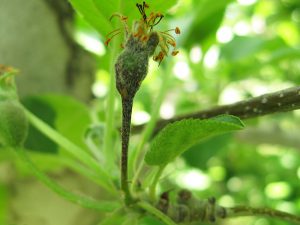
In the May 1 advisory, we discussed fire blight. Infections occur during warm, wet days where blossoms are still open on apple and pear. The following locations have an EXTREME risk of infection over the following dates:
- Box Elder County: May 14 – 20
- Cache County: May 16 – 19
- Davis, Weber, Salt Lake, and Utah counties: May 15 – 21
- Beaver, Carbon, Iron, Juab, Millard Sanpete, and Sevier counties: May 16 – 20
- New Harmony in Washington County: May 15 – 21
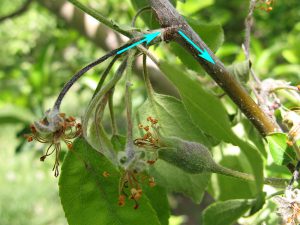
A chance of rain is expected Saturday and Sunday (May 13-14) in Utah County, so an antibiotic application may be warranted on late Saturday on the most susceptible varieties.
You can watch fire blight predictions on the Utah TRAPs website by selected a location closest to you, and then selecting Fire Blight in the ‘Pest’ drop-down.
Treatment
For commercial producers, most areas (except the southern part of Utah County, which has resistance) can use streptomycin. Where resistance occurs, producers should use oxytetracycline (MycoShield) or Kasumin. One application can be a mix of oxytetracycline and streptomycin.
Most diligent backyard growers should not need to apply an antibiotic. (Although if necessary, most garden centers carry streptomycin – “fire blight spray”.) Monitor trees closely starting two weeks after full bloom (which is when infections start to become visible). Prune out new infections immediately (on a dry day).
PEACH, NECTARINE, APRICOT, PLUM
Peach Powdery Mildew
Apply fungicide at shuck split stage
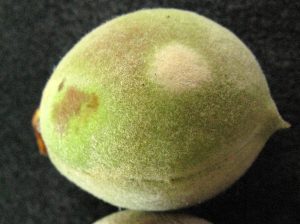
There are two fungal species that cause powdery mildew (PM) on peach. One is specific to peach (Sphaerotheca pannosa), affecting the foliage and fruit, and the other is apple powdery mildew (Podosphaera leucotricha), that only affects the fruit.
Peach PM overwinters on roses and sometimes on peach buds and bark. In spring, when nights are cool and moist, and days are warm, spores infect foliage (rarely) and peach fruitlets. On fruit, new lesions look like fuzzy, bright white spots. Fruit infections can occur all spring until the pit hardening stage. (The only way to tell pit-hardening is to slice peaches.) Infections on leaves are typically only seen later in the season.
Apple PM on peach is referred to as “rusty spot.” The fungus overwinters on apples only, and fruit of peach trees grown near apple trees with PM may be affected. On peach fruit, new lesions look pale whitish at first, and within a few days, the skin under the infection takes on a rusty-orange streaking.
Infections of either disease won’t be visible on fruit until 2 to 4 weeks after bloom. At that time, monitor 25 fruits on several trees for the presence of round, whitish, powdery spots on the fruit surface. A total of 10 to 20 fruit infections and greater than 20 fruit infections per tree represents moderate and high risk, respectively.
Susceptible varieties include Redskin, Rio Oso Gem, Elegant Lady, Fairtime, Fay Elberta, and Summerset.
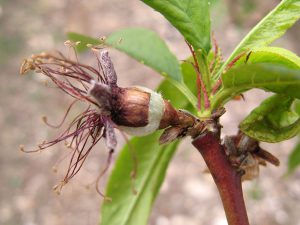
Peach powdery mildew can be prevented with a shuck-split or shuck-fall fungicide application.
Treatment
Find options for commercial growers by clicking here.
In residential settings, fruit that is infected is still edible to eat. If aesthetics is a concern, apply chlorothalonil or sulfur (organic) can be used (and will also help manage coryneum blight) at the shuck split stage. If a fungicide is needed after shuck split, use sulfur or Spectracide Immunox.
Continue fungicide sprays on susceptible varieties at 10 to 14-day intervals until the pit hardening stage is reached.
Peach Twig Borer
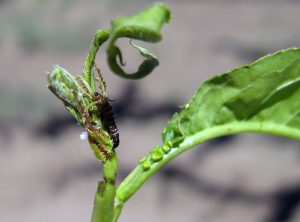
Peach, nectarine, apricot – spray dates for some areas of southern Utah
Peach twig borer is active in the warmest southern Utah locations. This pest prefers to feed inside succulent peach shoots, but later in the summer, it feeds inside the fruits themselves. It is best to knock the population down early rather than waiting until later.
Application timing dates (apply anytime in this range):
- Hurricane: May 15 – 17
- Leeds: May 19 – 22
- Moab: May 29 – June 1
- Springdale: May 20 – 23
- St. George: May 14 – 21
Treatment
Same as for codling moth.
